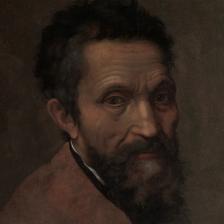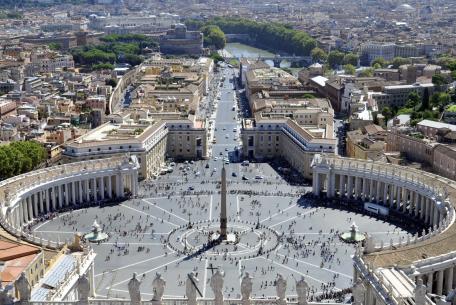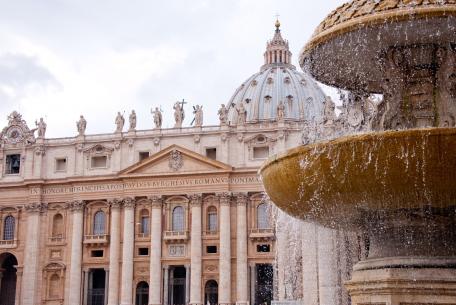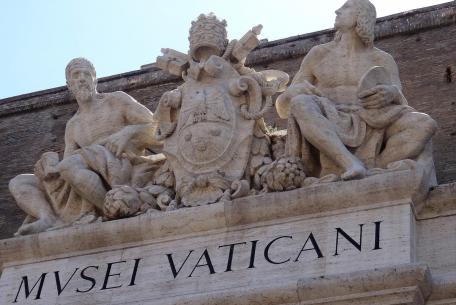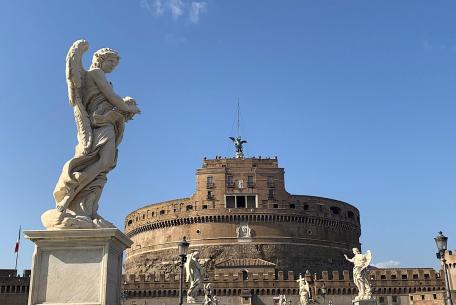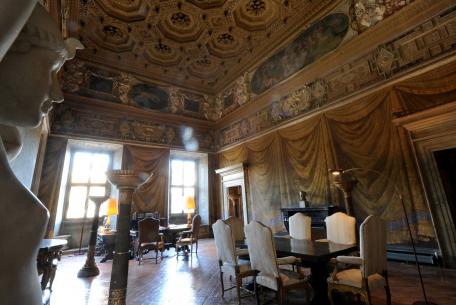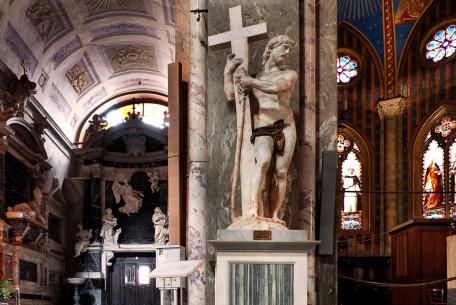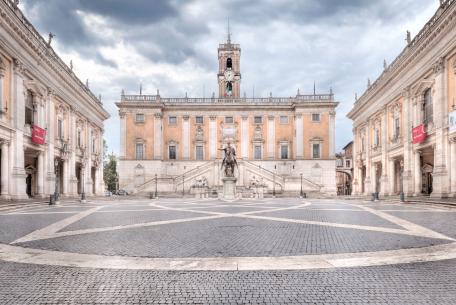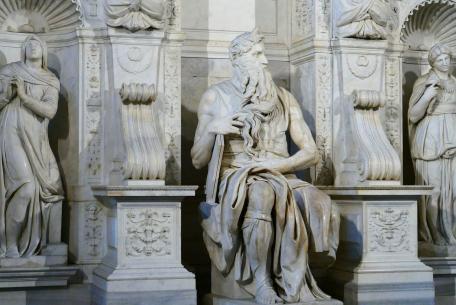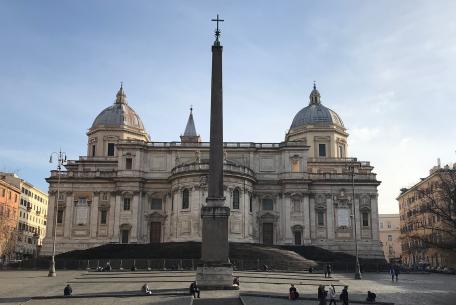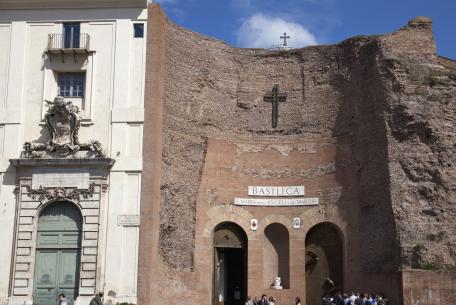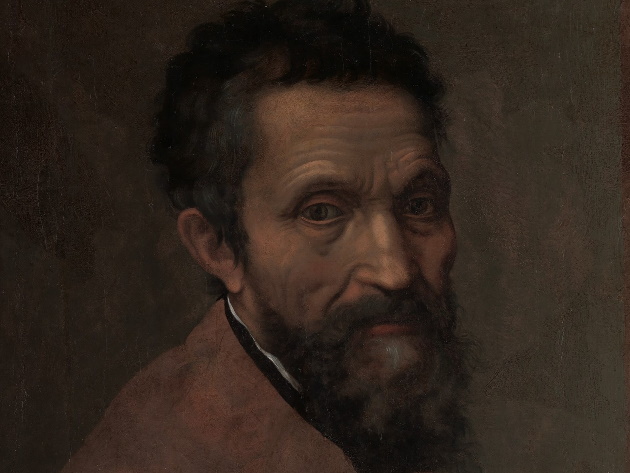
Michelangelo Buonarroti was born on 6th March 1475 in Caprese, a small village in Tuscany. His father, the chief magistrate Ludovico di Leonardo di Buonarroti Simoni and his mother Francesca di Neri del Miniato del Sera, were part of Florence aristocracy but at one point they had money problems and, decided to go back to Florence after Ludovico ended his assignment. Michelangelo’s mother died when he was only six.
Michelangelo started his training in the workshop of Domenico Ghirlandaio in 1488. Thanks to his extraordinary skills he entered the Giardino di San Marco and met the most famous humanists of his time at the court of Lorenzo the Magnificent, who, despite the artist’s indomitable character, appreciated his genius. Highly skilled sculptor, Michelangelo also excelled in poetry, encouraged by intellectuals and philosophers.
When Charles VIII and his army invaded Florence in 1494, he was forced to run away and found refuge in Bologna, where he ended some statues for the altar of San Domenico church. During his first stay in Rome (1496-1501), he was commissioned important works, such as the Pietà, thanks to the support of the rich banker Jacopo Galli. Michelangelo became famous but he started having disagreement with his most famous colleagues, among them Leonardo da Vinci, because of his indomitable character.
In March 1505, he was called to Rome by Julius II, who entrusted him with making his funeral monument.
It was the beginning of a long story of contrasts with the pope and his heirs that ended only in 1545 with the construction of the complex, today in San Pietro in Vincoli. In May 1508, after furiously quarrelling and reconciliating with Julius II, Michelangelo signed the contract to decorate the Sistine Chapel vault, at which he restlessly worked until 1512. He also realized important works in Florence and then again in Rome, where he made the Christ carrying the cross for the Basilica of Santa Maria sopra Minerva, between 1519 and 1520. He settled in Rome in 1534 and started to work to The Last Judgement in the Sistine Chapel until 1541. From 1542 to 1550 he frescoed the Pauline Chapel and planned various architecture works like accomplishing Palazzo Farnese, rearranging Campidoglio, and continuing to work on Saint Peter’s Basilica, for which he was engaged by Paul III in 1547. In the same years he became spiritually linked to Vittoria Colonna and made friends with the noble Tommaso de‘ Cavalieri, to whom he donated his designs.
Michelangelo worked almost to the end of his long life. He died on 18th February 1564 in his house in piazza di Macel de’ Corvi in Rome. The house was afterwards demolished during the works to expand Piazza Venezia. He was first buried in the Basilica of the Santi XII Apostoli, then brought back to Florence by the will of his nephew and buried in the Basilica di Santa Croce.
Download here the full itinerary
Piazza San Pietro
The Cupola and Basilica di San Pietro
The long lasting works to build Saint Peter’s Basilica as we know it today, started at the beginning of the XVI century, at the behest of Julius II, whose aim was to celebrate the grandeur of the Church with a new Basilica, due to rise in the same place where the existing magnificent church, built in the IV century by emperor Constantine, already stood. Works, commissioned to various famous artists, among which Michelangelo, went on until 1626. He was commissioned by Pius III and worked at the building from 1547 until his death. The artist did not draw up an overall project but preferred to proceed in individual parts. His vision of the basilica was deeply modified by Carlo Maderno, who completed it. Michelangelo also designed the church’s imposing dome, fondly called “il Cupolone” (ndt. The big Dome) by the Romans and still today, one of the most representative symbols of the church as well as of Rome. Michelangelo was inspired by Brunelleschi’s dome of Santa Maria del Fiore in Florence. Built by Michelangelo’s successors, the structure consists of an internal masonry dome and an external one in lead plates, between which is the path that allows climbing to the top of the dome to enjoy a splendid panorama of Rome. (visits on payment. Info: museivaticani.va).
La Pietà in the Basilica di San Pietro
The Pietà Vaticana is hosted in the first chapel in the right nave of the church. Michelangelo realized it between 1498 and 1499 and became one of the most estimated artists of his time thanks to the beauty and precision of his sculpture technics. He sculpted the white marble he had personally chosen in Carrara, with such a precision to obtain the effect of a true expression of the faces as well as true body and clothe details. The Virgin’s pain is enclosed in the sad expression of her young beautiful face, symbol of her purity. This is the only work Michelangelo signed on the band that surrounds the bust of the Virgin, after hearing people attributing the work to another artist.
Musei Vaticani
Cappella Sistina
The chapel, dedicated to the Assumption, was built on the upper floor of a fortified area of the Vatican Apostolic Palace, under pope Sixtus IV della Rovere, between 1475 and 1481. It has always been home to Conclaves and important ceremonies. When Julius II had to carry out restoration works, following the damage caused by a landslide, he also decided to replace the starry sky painted on the vault and entrusted Michelangelo with the task. The artist worked restlessly from 1508 to 1512. Suspended on a wooden scaffolding that he himself had designed, folded in uncomfortable positions, often lit by a faint candle, he frescoed the immense surface of 500 square meters. Being a perfectionist, he often modified details or even entire figures to improve the perspective impact from below. Pressed by the pope, he succeeded in ending the frescoes, today known and admired worldwide, in just four years. The Sistine Chapel restoration ended with pope Paul III Farnese who entrusted Michelangelo with frescoing the back wall of the altar too (1536- 1541). The 180 square metre surface is decorated with an imposing Last Judgement fresco, in accordance with the other themes. Almost 400 figures are represented while moving excitedly, generating an apocalyptic scene, maybe inspired by the artist’s advanced age and by the historical period (the Sack of Rome in 1527). Few years after the fresco was finished, the reform resulting from the Council of Trent, censored the nudes masterfully painted by Michelangelo, which were then covered with drapery by Daniele da Volterra and other painters. During the recent restoration, many of these elements were removed and the frescoes appeared again as originally foreseen by the master.
Cappella Paolina
Few steps from the Sistine Chapel, in the heart of Apostolic Palaces, is the Chapel of Saints Peter and Paul also known as Pauline Chapel, which is reserved only to the pope. The Chapel hosts the last imposing works realized by Michelangelo. After ending The Last Judgement, the artist, though old, could not refuse pope Paul III Farnese’s request to decorate his private chapel. He realized two big frescoes between 1541 and 1550. The Conversion of Saint Paul, on the right wall, pays homage to the pope’s name and at the same time reminds him of his role as keeper of orthodoxy. The Crucifixion of Saint Peter, on the left wall, dramatically alludes to the importance of papal morality, with the large eyes of the crucified Peter fixing the pope’s entrance door.
Castel Sant’Angelo
Along the southern side of the Cortile d’Onore in Saint Angel’s Castle there is an elegant aedicule window, designed by Michelangelo between 1514 and 1516. The work was commissioned by Leo X, when the fortress was transformed into a sumptuous papal residence. The window acts as a refined facade of the “new chapel” of saints Cosma and Damiano, protectors of de Medici family.
Palazzo Farnese
This palace, commissioned by Alessandro Farnese (future pope Paul III) to celebrate the grandeur of his family, hosts today the French Embassy and is considered one of the most imposing and elegant palaces in Rome (visits by reservation: it.ambafrance.org). Antonio da Sangallo il Giovane was directing the long-lasting works when he died in 1546 and Michelangelo was commissioned. He thoroughly modified the original project introducing architectural and decorative elements thus creating a dynamic effect. Buonarroti defines the layout of the first two floors and adds the third one, ends the internal courtyard and inserts the massive cornice decorated with the Farnese lilies. He also adds the central balcony and the pope’s crest, surmounted by the keys and tiara, on the facade. Michelangelo also plans a bridge across the Tiber that connects the Palace with Villa Chigi (Farnesina). The work was never completed due to the high costs, only a first part remains, known as Arco dei Farnesi, along the beautiful Via Giulia.
Basilica di Santa Maria sopra Minerva - Cristo Portacroce
The Dominican church, built on the area of the ancient Iseum, where Egyptian worship was practiced, houses the statue of Christ carrying the cross by Michelangelo. Christ, standing, while leaning on a symbolic cross because smaller than the real size, turns to look to the left. The artist skilfully represents the body twist, rich in anatomical details. Michelangelo created a first version but left it unfinished due to a defect in the marble, while the statue visible today was only sketched by him in Florence in 1518 and completed in Rome by his students in 1521. The body of Christ, originally totally naked, was later covered with a cloth made of gilded bronze, because of the censorship imposed by the Council of Trent.
Piazza del Campidoglio
The present extraordinary layout of this square, today the seat of the City Hall Authorities, was conceived by Michelangelo’s genius, commissioned by Paul III Farnese who wanted to redevelop the area on the hill so that it could worthily represent Rome’s grandeur. Works started in 1540 and went on for more than a century, directed by Michelangelo first and, after his death, by Giacomo Della Porta, Girolamo and Carlo Rainaldi. Michelangelo plans the area as a work of art by changing the general layout of the square according to its new urban function. He orients it towards the modern city, abandoning the Roman Forum view and designing the scenographic cordonata (ndt. a flight of low steps allowing the transit of horses), that connects the hill to Piazza dell’Ara Coeli. Michelangelo modifies the facades of Palazzo dei Conservatori by adding a portico, and Palazzo Senatorio with a staircase leading straight to the first floor. He then builds Palazzo Nuovo giving a slightly trapezoidal shape to the square and plans the marble basement in the middle of it, upon which Marcus Aurelius’ statue, symbol of the power, has been placed (the statue now in the square is a copy. The original one is hosted in the Capitoline Museums). The artist also designs the precious 12-pointed star-shaped pavement, which was realized, though slightly modified compared to the original one, only in 1940, when the underground gallery connecting the three palaces was excavated.
Basilica di San Pietro in Vincoli - Julius II’s Tomb
This church houses the funerary monument of Julius II. Michelangelo was commissioned by the pope itself in 1505. A tormented work that Michelangelo itself defined “a tragedy of the burial”, whose accomplishment absorbed him for about 40 years and will accompany him in the most troubled periods of his life and career. Thirty-two years after the pope’s death, years of works and negotiations with the pope’s family members, the sixth and final project was approved and realized. Its smaller dimensions with respect to the previous projects do not affect in any way this extraordinary architectural work. Leaning against a wall of the transept right arm, it develops on two levels. The most famous of the statues composing it, the splendid Moses, stands in the middle of the lower level. Recent restorations confirmed that Michelangelo modified the statue after ending it to make a prodigious twist, probably because of the censorship imposed by the Council of Trent.
Basilica di Santa Maria Maggiore - Cappella Sforza
The left nave second chapel, dedicated to Santa Maria Assunta, is the last architectural work designed and directed by Michelangelo when he was 87 years old. The project was completed by Tiberio Calcagni and Giacomo Della Porta. The brothers Guido Ascanio and Alessandro Sforza, who commissioned the work, are buried in the two big side niches of the chapel. Its elliptical-shaped space with its sail vaults and its domes supported by columns and pilasters, make this chapel the precursory work of Baroque architecture.
Basilica di Santa Maria degli Angeli e dei Martiri
The church was built inside the structure of Diocletian’s Baths, the largest baths in the city, at the behest of Pius IV who, as his predecessors, wanted to realize a project with a strong religious message. The pope commissioned Michelangelo to change this majestic pagan building into a place of worship. The artist utilizes the tepidarium, the four spaces opening on its sides and the spaces opening on the transverse axis, planning a Greek cross structure with three entrances, where the fourth arm is completed by an apsidal presbytery. The present decorations of the interior are the result of subsequent interventions that deeply changed it.
Porta Pia
This urban door, one of the 18 doors of the Aurelian walls, owes its name to Pius IV de‘ Medici, the pope who commissioned Michelangelo to redesign the ancient Porta Nomentana in 1561. The new access had to represent an imposing scenography on the Pia Road, which connected the papal palace of Monte Cavallo (Quirinale) with the Basilica of Sant’Agnese outside the walls, in the context of an urban redevelopment. The external portal, designed by Michelangelo, was probably built by Virginio Vespignani, who totally renovated the attic in 1853. The section of the walls at Porta Pia was the scene of the historic “breach”, opened by the Italian army in 1870 to conquer Rome and annex it to the Kingdom of Italy.
 Condividi
Condividi












































